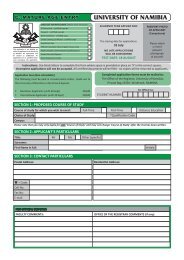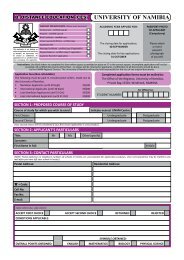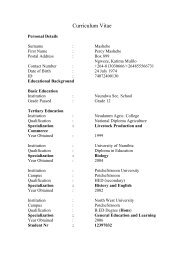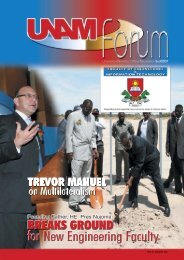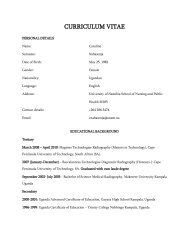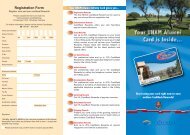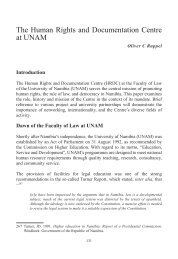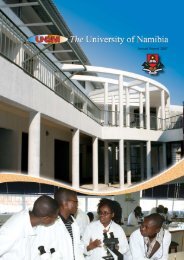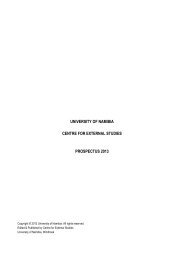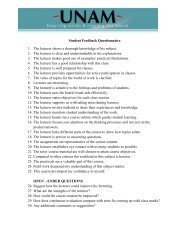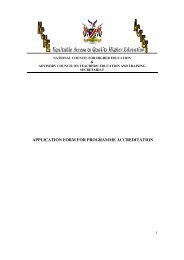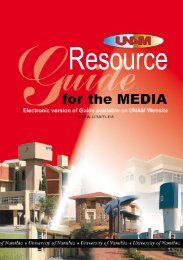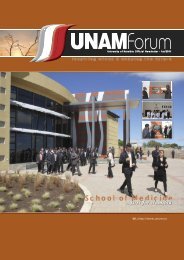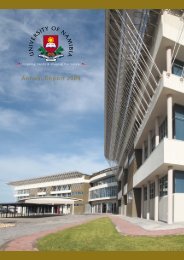SANUMARC Newsletter 2nd Edition - University of Namibia
SANUMARC Newsletter 2nd Edition - University of Namibia
SANUMARC Newsletter 2nd Edition - University of Namibia
You also want an ePaper? Increase the reach of your titles
YUMPU automatically turns print PDFs into web optimized ePapers that Google loves.
NewsOffi cial <strong>Newsletter</strong> <strong>of</strong> the Henties Bay Campus - <strong>2nd</strong> Ed 2012<strong>SANUMARC</strong> is an Operating Unit <strong>of</strong> the United Nations <strong>University</strong>’s Institute for Natural Resources in Africa
EditorialIt is our pleasure to present youwith the 2012 second edition<strong>of</strong> <strong>SANUMARC</strong> News – Offi cial<strong>Newsletter</strong> <strong>of</strong> UNAM’s Henties BayCampus. The success <strong>of</strong> the fi rstedition and positive commentsfrom all our readers has becomea driving force for the Centre tosustain this new initiative <strong>of</strong> biannual al newsletter and we arethankful to all our readers for your support, the response forthe fi rst edition has been positive and encouragingThe United Nations <strong>University</strong> Institute for Natural Resourcesin Africa (UNU-INRA) <strong>of</strong> which <strong>SANUMARC</strong> is an affi liatedoperating institute held an International Conference inAccra, Ghana from 05 – 07 December to mark its 25thanniversary. <strong>SANUMARC</strong> Director, Pr<strong>of</strong>. Omoregie and Ms.Hausiku (Mushroom Researcher) were among the gueststhat celebrated the 25th Anniversary. Read more about thecelebration inside this issue.The NAMSOV Community Trust has a respected trackrecord <strong>of</strong> empowering communities through education.The Namsov Community Trust endowed a NAD 1 millionTrust, known as The <strong>SANUMARC</strong> Trust and part <strong>of</strong> that fundhas been utilized to institute a Namsov Trust PostgraduateScholarship Scheme. At the moment, we are proudly havingthree postgraduate students at the Centre for which weare very grateful to NAMSOV Community Trust for providingan opportunity for these young scientists to develop theircareers in marine and coastal resources disciplines.As a Centre, we have a responsibility <strong>of</strong> transferring skillsand knowledge to our communities by assisting with variouscommunity development needs and training activities.The Centre provides training on mushroom production toHenties Bay community and beyond as well as providingtechnical assistance on horticulture projects and biogasconstruction. Since the end <strong>of</strong> last year the Centre hasstarted collaboration with National Youth Service (NYS). Thiscollaboration involved training in Mushroom productionand Horticulture at the Henties Bay Centre <strong>of</strong> NYS. Insidethis issue you will see how the youth have been providedtraining and what they have achieved so far. We are als<strong>of</strong>ocusing on reviving the biogas digester in the HentiesBay location area, the Centre will continue to promotebiogas use as a low cost source <strong>of</strong> energy, as well as anenvironmental management strategy.Lastly, I am really pleased that our team is growing, we haveadditional staff members and their pr<strong>of</strong>i les are includedin this issue. This staff growth has a great positive effecton strengthening our research activities at the Centre.Noteworthy here is to mention that since the inception <strong>of</strong>the Centre in 1999, this is the very fi rst time that the Centre ishaving a qualifi ed Librarian to manage its Resource Centre,a development attributed to the incumbent Director.ContentsNAMSOV Community Trust ...........................4Update on SPACES .......................................4Fellowships in Germany ................................6Bioplastic Research .......................................6UNU-INRA 25th Anniversary ..........................8New Faces at <strong>SANUMARC</strong> ...........................8Community Outreach ................................10Fisheries & Aquatic Sciences .....................12High Delegation Visit ...................................12Writing Research Proposals ........................12Biogas as Sustainable Energy ....................14Until next time!Dr Diina ShuulukaEditor-in-Chief
4NAMSOV COMMUNITY TRUSTCapacity Building at Postgraduate LevelThe Namsov Community Trust endowed a NAD 1million Trust Fund, known as The <strong>SANUMARC</strong> Trustfor the Sam Nujoma Marine and Coastal ResourcesResearch Centre. One <strong>of</strong> the objectives <strong>of</strong> this Trustis to fund research activities at the Centre that fallsunder the Research Mandate <strong>of</strong> <strong>SANUMARC</strong> andbenefi cial to the <strong>Namibia</strong>n Nation.At one <strong>of</strong> <strong>SANUMARC</strong>’s Board meetings, mandate was givento the Management <strong>of</strong> the Centre to incorporate capacitybuilding in Marine Sciences as one <strong>of</strong> the activities to besupported by the Trust. To achieve this initiative, a NamsovPostgraduate Fellowship Scheme was inaugurated.For the 2012 and 2013 academic years, from 18 applicationsreceived, 3 were selected as the fi rst benefi ciaries <strong>of</strong> thisfellowship. The successful applicants are Mr. Johannes A.Iitembu (PhD Student registered with Rhodes <strong>University</strong>), Ms.Johanna K. Dijerenge and Mr. Emmanuel Vellemu (both MScstudents registered with the <strong>University</strong> <strong>of</strong> <strong>Namibia</strong>). Both Mr.Iitembu and Ms. Dijerenge are staff <strong>of</strong> the Ministry <strong>of</strong> Fisheriesand Marine Resources (MFMR).respectively on a one year contract made possible throughthe funding provided by Namsov Community Trust. Mainresponsibility is to ensure cleanliness <strong>of</strong> the laboratories as wellas providing support to fellows <strong>of</strong> the Namsov PostgraduateScholarship scheme in the laboratories....mandate was given to the Management<strong>of</strong> the Centre to incorporate capacitybuilding in Marine Sciences as one <strong>of</strong> theactivities to be supported by the Trust.Ms. Anna Kharuchas and Mr. Johan de Klerk were recentlyengaged as Laboratory Attendant and Labourer respectivelyon a one year contract made possible through the fundingprovided by Namsov Community Trust.<strong>SANUMARC</strong> is very grateful to the Namsov Community Trust forthe endowment funds which will provide signifi cant trainingand development opportunities for young scientists to assistthem in developing their careers in Marine Science.In related news, Ms. Anna Kharuchas and Mr. Johan de Klerkwere recently engaged as Laboratory Attendant and Labourer
UPDATE ON SCIENCE PARTNERSHIPSFOR THE ASSESSMENT OF COMPLEXEARTH SYSTEM PROCESSES(SPACES)5Research outputs from the GermanRV Maria S. Merian Research CruiseSUPPORT:Main Photo: John Rittmann<strong>SANUMARC</strong> is verygrateful to the NamsovSeveral research outputs from the German RV Maria S. Merian research cruise wereachieved coupled with the cruise objectives <strong>of</strong> capacity building within the Region.Posters from some <strong>of</strong> the research activities during the cruise were presented at the3rd Annual Science Symposium <strong>of</strong> the Benguela Current Commission (BCC) held inSwakopmund, from 17 to 19 October. Below are some titles <strong>of</strong> research undertaken byUNAM students on the cruise.• Distribution <strong>of</strong> main ichthyoplankton in the Benguela Upwelling System• Frequency <strong>of</strong> occurrence <strong>of</strong> seabirds, marine mammals and jellyfi sh in Central<strong>Namibia</strong>n waters• Nutrient cycle and the relevance <strong>of</strong> the Benguela Upwelling System for thebiological pump• CO2 emission from the Benguela Upwelling System• An assessment <strong>of</strong> spatial and vertical trends in meso-zooplankton in the upwellingsystems <strong>of</strong>f <strong>Namibia</strong>• Distribution <strong>of</strong> Microzooplankton in the northern Benguela upwelling Region <strong>of</strong> the<strong>Namibia</strong>n coastCommunity Trust forthe endowment fundswhich will providesignificant trainingand developmentopportunities for youngStudents in one <strong>of</strong> the laboratories on board RV Maria SMerian during the research cruise.scientists to assist themin developing theircareers inMarine Science.
6EIGHT FORMER UNAM STUDENTS BENEFSPACES MSc Fellowship in GermanyThe Pro Vice-Chancellor (Finance andAdministration), Dr. Boniface Mutumba and theDirector <strong>of</strong> the Sam Nujoma Marine and CoastalResources Research Centre (<strong>SANUMARC</strong>), Pr<strong>of</strong>.Edosa Omoregie represented the <strong>University</strong> in thejust concluded SPACES meeting hosted by theBrandenburg Technical <strong>University</strong> (BTU), Cottbus in Germanyfrom 10 to 13 May, 2012. From the total <strong>of</strong> 13 students fromAngola, South African and <strong>Namibia</strong>, who were awarded theSPACES MSc Fellowship to study in various German Institutions,8 were <strong>Namibia</strong>ns and all <strong>of</strong> them former students from UNAM.Dr. Mutumba and Pr<strong>of</strong>. Omoregie met with the studentsduring a dinner party organised by the President <strong>of</strong> BTUand socialised with them in a relaxed atmosphere were thestudents expressed themselves.SPACES Scholarships for Post Graduate Studies in Germany aimsto acquaint young scientists from South Africa, <strong>Namibia</strong> andAngola with the SPACES research projects at an early stage.Therefore, the scholarship programme <strong>of</strong>fers the opportunity toexcellent post graduates from the above mentioned countriesto study in selected M.Sc. courses at German universities, Aftera four-month German course, all students are now studying inselected Master’s degree programs in Universities in Bremen,Cottbus, Greifswald and Kiel.A good news from the SPACES meeting at BTU is that BMBFwill within the next couple <strong>of</strong> weeks announce a scholarshipprogramme for PhD candidates. The selected candidateswill conduct research related to their thesis within the SPACESprogramme.Some <strong>of</strong> the <strong>Namibia</strong>ns studying for Master’s degree at variousGerman Universities under the SPACES programme posinghere for the camera with Dr. B Mutumba, Pro-Vice Chancellor:Finance & Administration <strong>of</strong> the <strong>University</strong> <strong>of</strong> <strong>Namibia</strong> (Backrow, third from right), and Pr<strong>of</strong> Omoregie, the Director <strong>of</strong><strong>SANUMARC</strong> (Back row, <strong>2nd</strong> from left).
BIOPLASTIC RESEARCH ATUNAM IN PARTNERSHIP WITHTHE AFRICA MATERIALSSCIENCE AND ENGINEERINGNETWORK (AMSEN)7ITING FROMMain Photo: John RittmannAfter a fourmonthGermancourse, allstudents arenow studying inselected Master’sdegree programsin Universities inBremen, Cottbus,Greifswaldand Kiel.AMSEN is one <strong>of</strong> five African networks that were selected for funding in 2008 bythe American-based Regional Initiative in Science and Education (RISE). The<strong>University</strong> <strong>of</strong> <strong>Namibia</strong> is one <strong>of</strong> five RISE networks in Africa. The other universitiesare Wits <strong>University</strong>, <strong>University</strong> <strong>of</strong> Botswana, <strong>University</strong> <strong>of</strong> Nairobi in Kenya andthe Federal <strong>University</strong> <strong>of</strong> Technology in the Nigerian city <strong>of</strong> Akure. RISE strives toassist participating African universities to develop and retain faculty membersthrough joint research, post-graduate training, sustainable collaboration andsmall grants for equipment, attending conferences and publication <strong>of</strong> findingsin peer reviewed journals. The fi rst AMSEN workshop was held in Windhoek in2010.At the recent <strong>2nd</strong> AMSEN workshop held in Kenya, Ms. Naomi Shifeta, a<strong>Namibia</strong>n MSc student funded by AMSEN delivered a proposal on theproduction <strong>of</strong> bioplastics from seaweed. Naomi will carry out her researchunder the supervision <strong>of</strong> Pr<strong>of</strong>. Frank Kavishe, the <strong>Namibia</strong>n node coordinatorfor AMSEN and co-supervised by Dr. Erold Naomab and Dr. Diina Shuuluka.The choice <strong>of</strong> Gracilaria for this research is due to their abundance alongthe southern <strong>Namibia</strong>n coastline and they contain agar, a natural polymermade from repeating units <strong>of</strong> galactose, which contain carbon and can beused to create a bioplastic. Agar is widely used particularly in the fi elds <strong>of</strong>biotechnology, food technology, and microbiology but not yet in the plasticindustry.Naomi’s research will be geared towards the development <strong>of</strong> a bioplasticusing agar from Gracilaria gracilis. It aims to create a bioplastic that will havecomparable tensile strength and chemical resistance to the petroleumbasedplastics in use today. This work will include harvesting Gracilaria fromthe fi eld, extracting its agar, manufacturing the bioplastic, and testing itsbiodegradability, tensile strength, and general chemical resistance. DrShuuluka, seaweed research expert at <strong>SANUMARC</strong>, noted that the outcome<strong>of</strong> this project will serve as a springboard for commercial cultivation andprocessing <strong>of</strong> seaweeds for the production <strong>of</strong> bioplastic, thereby adding valueto <strong>Namibia</strong>n seaweed resources.
8Group photographs during the International Conference onNatural Resources in Africa to mark the 25th Anniversary <strong>of</strong>UNU-INRAUNITED NATIONS UNIVERSITY INSFOR NATURAL RESOURCES IN AFRICA 25TH ANNIVERSARYThe United Nations <strong>University</strong> Institute for NaturalResources in Africa (UNU-INRA) <strong>of</strong> which<strong>SANUMARC</strong> is an affiliated operating instituteheld an International Conference in Accra,Ghana from 05 – 07 December to mark its25th anniversary. The three-day internationalconference was attended by representatives fromgovernment Ministries, Departments and Agencies inGhana; the diplomatic community, UNU staff worldwide,the donor community, as well as academics from variousuniversities across the world.Pr<strong>of</strong>. Osterwalder, the Rector <strong>of</strong> the United Nations <strong>University</strong>,congratulated UNU-INRA for organizing a successfulconference and admonished participants to actively think <strong>of</strong>The conference wasalso to mobilize Africanperspectives on thedevelopment <strong>of</strong> naturalresources for the Rio +20conference onsustainable developmentin 2012.how to support the Institute and its operating units in differentparts <strong>of</strong> Africa and its twinning partner in Tokyo.<strong>SANUMARC</strong> participated actively in this event; Pr<strong>of</strong>essorOmoregie presented a paper on Mushroom research andactivities in <strong>Namibia</strong>.The conference, among other things, created the platformfor dialogue amongst academics and policy makers oncharting a new course for future research, training andcapacity development in Africa. It was also to mobilize Africanperspectives on the development <strong>of</strong> natural resources for theRio +20 conference on sustainable development in 2012.Ms. Martha Hausiku standing next to her poster presentationat the UNU-INRA 25th annivesary.
9NEW ADDITIONS TO THE <strong>SANUMARC</strong>’S FAMILYMs. Linea Iipinge: <strong>SANUMARC</strong> now has aqualifi ed Librarian in the person <strong>of</strong> Ms. LineaIipinge. Linea has a Bachelor <strong>of</strong> Art degreein Library Science and Record Managementmajoring in Economics obtained fromthe <strong>University</strong> <strong>of</strong> <strong>Namibia</strong> in 2007. She haspreviously worked as a Library Assistant forMinistry <strong>of</strong> Gender Equality and ChildrenWelfare at Ongwe diva where she assisted theLibrarian in managing library collection andpublications. She also worked as a Librarianat Oshakati Community Library, Directorate <strong>of</strong> Education, Oshana Region. She wasresponsible for planning library activities, monitor and planning <strong>of</strong> library budget aswell as training teachers on how to manage schools libraries. We are very pleased towelcome Ms. Iipinge to <strong>SANUMARC</strong> as she is bringing along a wealth <strong>of</strong> experience.TITUTEPr<strong>of</strong>. Osterwalder...admonishedparticipants toactively think <strong>of</strong>how to supportthe Institute andits operating unitsin different parts<strong>of</strong> Africa and itstwinning partnerin Tokyo.Mr. Gadaffi Liswaniso: Joined <strong>SANUMARC</strong> as aMarine Science Researcher at the beginning<strong>of</strong> 2012. Gadaffi successfully completed hisMasters <strong>of</strong> Science in Fisheries and MarineResources from Ningbo <strong>University</strong> in thePeople’s Republic <strong>of</strong> China. His researchwas to study the diversity and dynamics <strong>of</strong>Vibrio related bacteria in crab ponds usingmolecular approach based on the 16S rDNA.His research was driven by the fact thatvibrionaceae family is composed <strong>of</strong> severalpathogenic species that cause diseases in humans such as cholera and othergastroenteritis related diseases that may arise mainly from eating undercookedseafood. Mr. Liswaniso is currently researching on several methods to inducespawning <strong>of</strong> oysters at <strong>SANUMARC</strong> and the research outputs can be used by localoyster farmers to acquire their own spat using their broodstock oysters.Mr. Andreas Namwoonde: Joinedthe Centre as Renewable EnergyResearcher, he obtained his Master <strong>of</strong>Engineering and Technology (ChemicalEngineering) from D. I. Mendeleyev<strong>University</strong> <strong>of</strong> Chemical Technology <strong>of</strong> Russia,Moscow, Russia in 2011. Prior to joining theCentre, he worked briefl y as part-timeLecturer at the Department <strong>of</strong> Chemistry andBiochemistry <strong>of</strong> the <strong>University</strong> <strong>of</strong> <strong>Namibia</strong>,teaching Inorganic Chemistry, where he stillhelps to teach the same subject occasionally. Currently Mr. Namwoonde is busyworking on a Biogas project, looking at new and more manageable Biogas digesterdesigns with the aim <strong>of</strong> promoting biogas as a sustainable energy for <strong>Namibia</strong>.Mr. Edgar Mowa: Joined <strong>SANUMARC</strong>as Coastal Agriculture and Desert PlantBiodiversity Research towards the ending <strong>of</strong>2011. Edgar obtained a Master <strong>of</strong> Sciencedegree in Biodiversity Management andResearch from the <strong>University</strong> <strong>of</strong> <strong>Namibia</strong> in2009. He worked at the Ministry <strong>of</strong> Agriculture,Water and Forestry as a Forest Researcherbefore joining <strong>SANUMARC</strong> in 2011 as aDesert & Coastal Agriculture Researcher. Hisacademic expertise/interest is Sustainableagriculture, Crop Science, Horticulture, Landscape Ecology, GIS & Remote Sensing,Environmental conservation Science, Research and Land Use Planning. His currentproject at <strong>SANUMARC</strong> include Saliconia species; looking at the feasibility study onpotential <strong>of</strong> cultivation and supplying <strong>of</strong> these halophytic species as fodder forlivestock in <strong>Namibia</strong> as well as research in hydroponics
10Members <strong>of</strong> the National Youth Service proudlydisplaying the mushrooms cultivated by themduring the training activities.COMMUNITY OUTREACHat the Centre & ElsewhereMushroom production training at the CentreAs part <strong>of</strong> community service, <strong>SANUMARC</strong> embarked uponan intensive training <strong>of</strong> youths from National Youth Serviceon mushroom cultivation techniques. The training affordedthe youth an opportunity to experience techniques ondevelopment <strong>of</strong> good quality spawn and they have been hardat work developing spawn and inoculating bags throughoutthe duration <strong>of</strong> the training. <strong>SANUMARC</strong> will continue to assistthese youth through mentorship and technical advice toensure that their envisaged mushroom farming projects seethe light <strong>of</strong> day.In addition, the centre has also provided training to theyouth trainees from Luderitz Bay following a request from theRegional Councillor <strong>of</strong> Luderitz Constituency, Hon. Revd. J.A.Scholtz. The training was “hands-on” as the trainees had anLearners from one <strong>of</strong> the Schools keenly listening to apresentation by one <strong>of</strong> <strong>SANUMARC</strong>’s Researchers.opportunity to practice the techniques used in mushroomcultivation. The group showed enthusiasm and indicatedthat upon their return to Luderitz Bay, they will update theirRegional Councillor on the training and request for provision <strong>of</strong>a mushroom house where they would grow their mushrooms.Science and Technology Promotion<strong>SANUMARC</strong> encourages visits to the Centre and <strong>of</strong>ten receives“walk-in” visitors on a regular basis, whether they are curioustravellers, visiting scientists or students. The staffs are always readyto engage with visitors and a number <strong>of</strong> educational institutionsvisit the Centre on an annual basis, with more requesting tours<strong>of</strong> the Centre every year. Mr. Marthinus Kooitjie is responsiblefor leading the orientation activities around the Centre. Sincethe fi rst edition <strong>of</strong> our newsletter, the following educationalinstitutions visited <strong>SANUMARC</strong>: (continued next page)Students from the Department <strong>of</strong> Biology conductingpractical session at <strong>SANUMARC</strong> wet laboratory.
...COMMUNITY OUTREACH continued from page 10• Final Year Ecology Students (Unam-Rundu Campus),• Biological Sciences Students (Unam-Main Campus),• Omutundungu Combined School (Omusati Region).• Erundu Secondary School (Oshakati)11Tulongeni Garden Project<strong>SANUMARC</strong> continued to support the Tulongeni Garden and Mushroomprojects in Henties Bay. Besides helping with the preparation <strong>of</strong> mushroomspawning and the supply <strong>of</strong> various materials to the Tulongeni MushroomProject in previous years, the <strong>SANUMARC</strong> research team also helped in landtilling and sowing <strong>of</strong> seeds into the prepared soil at the garden project.<strong>SANUMARC</strong> willcontinue to assistthese youth throughmentorship andtechnical advice<strong>SANUMARC</strong> team at the Tulongeni Community Gardenin Henties Bay.<strong>SANUMARC</strong> IN COLLABORATION WITH THE NATIONALYOUTH SERVICE (NYS), HENTIES BAY TEAMThis collaboration involved training in Mushroom production and Horticulture.The Supervisor <strong>of</strong> NYS, Henties Bay team, Mr. Simeon Peelo Ndjelekeni is verypleased with the collaboration and said remarkable skills has been gained bytheir team from this collaboration as they have contact with Researchers ona daily basis. A number <strong>of</strong> horticulture production technologies implementedat NYS Henties Bay Centre has been advised by <strong>SANUMARC</strong>, these includeshydroponic fl oating system, polyethylene plastic pots fi lled with Omaruru riversand, use <strong>of</strong> seaweed as organic fertilizers and vegetable production undershade net structures. Mr. Ndjelekeni believed this has been a great opportunityfor Youth Trainees to accumulate skills that they require in their sphere <strong>of</strong> life,thus ultimately, “shaping youth into productive citizens”.to ensure thattheir envisagedmushroom farmingprojects see the light<strong>of</strong> day.Mr. Simeon Peelo Ndjelekeni -Supervisor NYS Henties Bay team.
12FISHERIES AND AQUATIC SCIENCEFinal Year Student’s ProjectMr. Stephanus Hamutenya, a fi nal year studentfrom the <strong>University</strong> <strong>of</strong> <strong>Namibia</strong> Department<strong>of</strong> Fisheries and Aquatic Sciences spent2 months at the Centre carrying out hisexperiments for his fi nal year project onGrowth rates <strong>of</strong> Gracilariopsis funicularis (Gracilariaceae,Rhodophyta) in laboratory culture under varying salinities.Among some <strong>of</strong> the seaweeds species in <strong>Namibia</strong> the twomost important agars producing gracilarioid are Gracilariagracilis and Gracilariopsis funicularis. In cultivating theseseaweeds, it is important to maintain growth condition inoptimal range to reduce the duration <strong>of</strong> cultivation andensure the greatest yield. For a species acclimated to aparticular set <strong>of</strong> environmental conditions, the optimal growthis always achieved at a specifi c combination <strong>of</strong> salinity andirradiance. This research focused on investigating the growthrate <strong>of</strong> Gracilariopsis funicularis in varying salinity levels underlaboratory conditions. This research provided benchmarkinformation for future study on the eco-physiology <strong>of</strong> the redseaweed species, Gracilariopsis funicularis in <strong>Namibia</strong>.
FOUNDING PRESIDENT,DR SAM NUJOMA ANDPROF. KETO MSHINGENIPAID AN IMPROMTU VISIT13SAmong some <strong>of</strong>the seaweedsspecies in<strong>Namibia</strong> the twomost importantagars producinggracilarioidare Gracilariagracilis andGracilariopsisfunicularis.Front Row: Pr<strong>of</strong> Omoregie, Pr<strong>of</strong> Mwandemele. Pr<strong>of</strong> Mshigeni and Dr Sam Nujomacaptured with some students at the Centre on their visit.The Founding President, Dr Sam Nujoma and Pr<strong>of</strong>. Keto Mshingeni visited<strong>SANUMARC</strong> during their December holiday. They were accompanied by thePro Vice-Chancellor, Pr<strong>of</strong>. Osmund Mwandemele. The Director, Pr<strong>of</strong>essor EdosaOmoregie gave a guided tour <strong>of</strong> the Centre’s facilities. Though the visit wasan impromptu one, three research students were around and they proudlyexplained their research to the Founding president and Pr<strong>of</strong>. Mshingeni, whomthe Centre’s Marine Aquaculture Laboratory is named after for his immersedcontributions to research in <strong>Namibia</strong>n Natural Resources.IN-HOUSE WORKSHOPON WRITINGRESEARCH PROPOSALSAs part <strong>of</strong> capacity building and mentoring <strong>of</strong> young researchers at the Centre,<strong>SANUMARC</strong> held a one day research skills development in-house workshophighlighting the importance <strong>of</strong> research, guidelines <strong>of</strong> writing scientifi c papersand presentations <strong>of</strong> research fi ndings. This workshop was aimed to enhance thecapability <strong>of</strong> young researchers and ensure that the research conducted meetsboth prescribed ethical and quality standards. The Research Coordinator forthe <strong>University</strong> <strong>of</strong> <strong>Namibia</strong>, Pr<strong>of</strong>. Isaac Mapaure, Deputy Director <strong>of</strong> PostgraduateSchool, Dr. Percy Chimwamurombe, ZERI Coordinator, Mrs Pauline Kadhila-Muandingi and Pr<strong>of</strong>. Omoregie delivered informative presentations that werevery motivating. The Researchers and students were very grateful for this initiativeand looking forward to these thematic workshops in the near future.u
14Main Photo: Bio digester constructed by <strong>SANUMARC</strong>at the Omdel Community in Henties Bay.BIOGAS AS A SUSTAINABLE ENERGFor <strong>Namibia</strong>In recent years, <strong>Namibia</strong> has reached an important crossingpoint <strong>of</strong> growing energy demand therefore a sustainableenergy resource need to be utilized. <strong>Namibia</strong> is adeveloping country with majority <strong>of</strong> population living in ruralarea, many <strong>of</strong> these, has no access to electricity or reliablesource <strong>of</strong> energy. So, how can <strong>Namibia</strong> solve the vast energydemand, while still paying attention to environmental-friendly,less health hazardous, renewable and green alternativesource <strong>of</strong> energy?Biogas has arisen as environmental friendly source <strong>of</strong> energywhich apart from providing clean fuel it also reduce wastedisposal problem on domestic scale or commercial scale.Biomethane known as biogas is a product <strong>of</strong> anaerobicdigestion, which is a sequence <strong>of</strong> processes in whichmicroorganisms break down the biomass in absence <strong>of</strong>oxygen. Biomass can be in the form <strong>of</strong> livestock, vegetablewaste, and poultry dropping, municipal solid waste, sewagewater, industrial solid effl uent, and land fi ll etc. Currently biogasis used for cooking and lighting purposes in rural areas in somedeveloping countries like India and for power and heating inEurope. Further purifi cation <strong>of</strong> biogas can make alternativefuel for automobiles and it can be compressed into cylindersand used as liquefi ed gas.Biogas TechnologyThe gasifi cation <strong>of</strong> biomass, commonly known as biomethanationhappens in air tight chamber where organicmaterial are subjected to anaerobic digestion in the presence<strong>of</strong> methanogenic bacteria. This process is superior to biomasscombustion as the digested slurry from the biogas digesteris available as enriched organic fertilizer for utilization inagriculture, horticulture etc. The slurry can be dried, packedand transported to be used somewhere else, as supplementor substitute to chemical fertilizers. In comparison, whenbiomass is used as energy source through combustion, theprocesses destroy much <strong>of</strong> the biomass, ash which remainsafter energy extraction, has less nutritional value in contrastto biogas digester slurry. Converting biomass into gaseous fuelthrough bio-methanation has more advantages and moresustainable than combustion.Biogas contains about 60% methane, 39% carbon dioxideand traces <strong>of</strong> gases like hydrogen sulphide, and ammonia.It is hydrogen sulphide which is responsible for odor usuallyassociated with biogas in many cases. Without any purifi cationit can be used for cooking, lighting and as supplement todiesel for electricity generation.Four biogas digester build in Omdel informal settlementAs in many towns country wide, Henties Bay is also faced withinformal settlement problem, whereby most <strong>of</strong> inhabitants <strong>of</strong>these informal settlements are low income earning citizens. Tohelp with energy supply, <strong>SANUMARC</strong> supervised construction<strong>of</strong> four digesters and skill transfer was carried out to educatethe local community on the importance <strong>of</strong> biogas digestersand their maintenance.The types <strong>of</strong> bio-digesters build is underground dome-shapedigesters, with the volume <strong>of</strong> 16 m3. The digesters are fed with
kitchen waste and sewer from municipal septic tank. Daily feed intake is 5 to 10kg kitchen waste and 10 to 15 liters <strong>of</strong> water. All that can results in gas supplyenough for 4 to 5 hours <strong>of</strong> nonstop cooking per day.The community understands the importance for having a domestic bio-digester,mainly for saving money on cooking, as the gas produced is piped directly tothe kitchen stove and is ready for use.<strong>SANUMARC</strong> Bio-digesterFor research purposes a biogas model was built at <strong>SANUMARC</strong>. This is a 100-literwater tank which was modifi ed and converted to airtight chamber, with inlet forfeeding and two outlets for gas and slurry respectively. It is fed with garden wasteand plants materials found around the Centre. With it, it will help researchers t<strong>of</strong>i nd out which types <strong>of</strong> biomass can yield more biogas and help in fi nding asimple and sustainable biogas purifi cation method.Y SOURCEFurtherpurificationAdvantages <strong>of</strong> Biogas• With the availability <strong>of</strong> biomass, biogas is a renewable source <strong>of</strong> energy witha constant supply to consumers• Slurry and grey water from digester are high quality organic fertiliser• The use <strong>of</strong> biogas, contribute signifi cantly to the protection <strong>of</strong> environment• Once build, bio-digester is maintenance free system• Biogas is less air pollutant compared to burning wood or using paraffi n forcooking• Effectiveness <strong>of</strong> livestock, municipal and industrial waste management• The digester can be built with local sourced materials• Improved sanitation within farming areas, townships and industries• Excess gas produced can be bottled and sold for income generation, thuscontribute to employment creation for locals• Using methane as fuel before it escape in atmosphere, will signifi cantlyreduce global warming and slow down the pace <strong>of</strong> climate change<strong>of</strong> biogascan makeFlow-Chart <strong>of</strong> BiogassDigesteralternative fuelfor automobilesand it can becompressedinto cylindersand used asliquefied gas.MRS. ANNA ANDJENGO REPLACESMRS. ELIZABETH HILL AS OFFICEADMINISTRATORMs. Anna Shiimi Andjengo joined <strong>SANUMARC</strong> team as anOffi ce Administrator after Mrs. Elizabeth Hill was transferredto the Main Campus at the beginning <strong>of</strong> 2012. Mrs. Shiimi-Andjengo hold a Diploma in Information Studies and Certifi catein Mid-level Management from the <strong>University</strong> <strong>of</strong> <strong>Namibia</strong> and aSecretarial Certifi cate from Rossing Foundation. She had previously worked for the Ministry<strong>of</strong> Education as a Library Assistant before joining the academic library setting in 2005at Polytechnic <strong>of</strong> <strong>Namibia</strong>. In 2008, she was appointed at the <strong>University</strong> <strong>of</strong> <strong>Namibia</strong> asa Library Assistant and later appointed to a Senior Library Assistant, Oshakati Campus.She possesses good secretarial and administrative skills with extensive knowledge <strong>of</strong>disseminating information. She is currently enrolled for a Diploma in Public Relations withthe <strong>University</strong> <strong>of</strong> <strong>Namibia</strong>. We are very pleased to have her joined our team as she has astrong academic background and wealthy <strong>of</strong> experience.
Contact Details:Editor: Dr Diina ShuulukaSam Nujoma Marine & Coastal Resources Research CentreP O Box 462Henties Bay<strong>Namibia</strong> +264-64 502 632Fax: +264-64 502 608E-mail: dshuuluka@unam.nahttp://www.unam.na/centres/hentiesCover Pics: John Rittmann



